NISSAN ALTIMA 1996 U13 / 1.G Owner's Guide
Manufacturer: NISSAN, Model Year: 1996, Model line: ALTIMA, Model: NISSAN ALTIMA 1996 U13 / 1.GPages: 183, PDF Size: 1.38 MB
Page 31 of 183
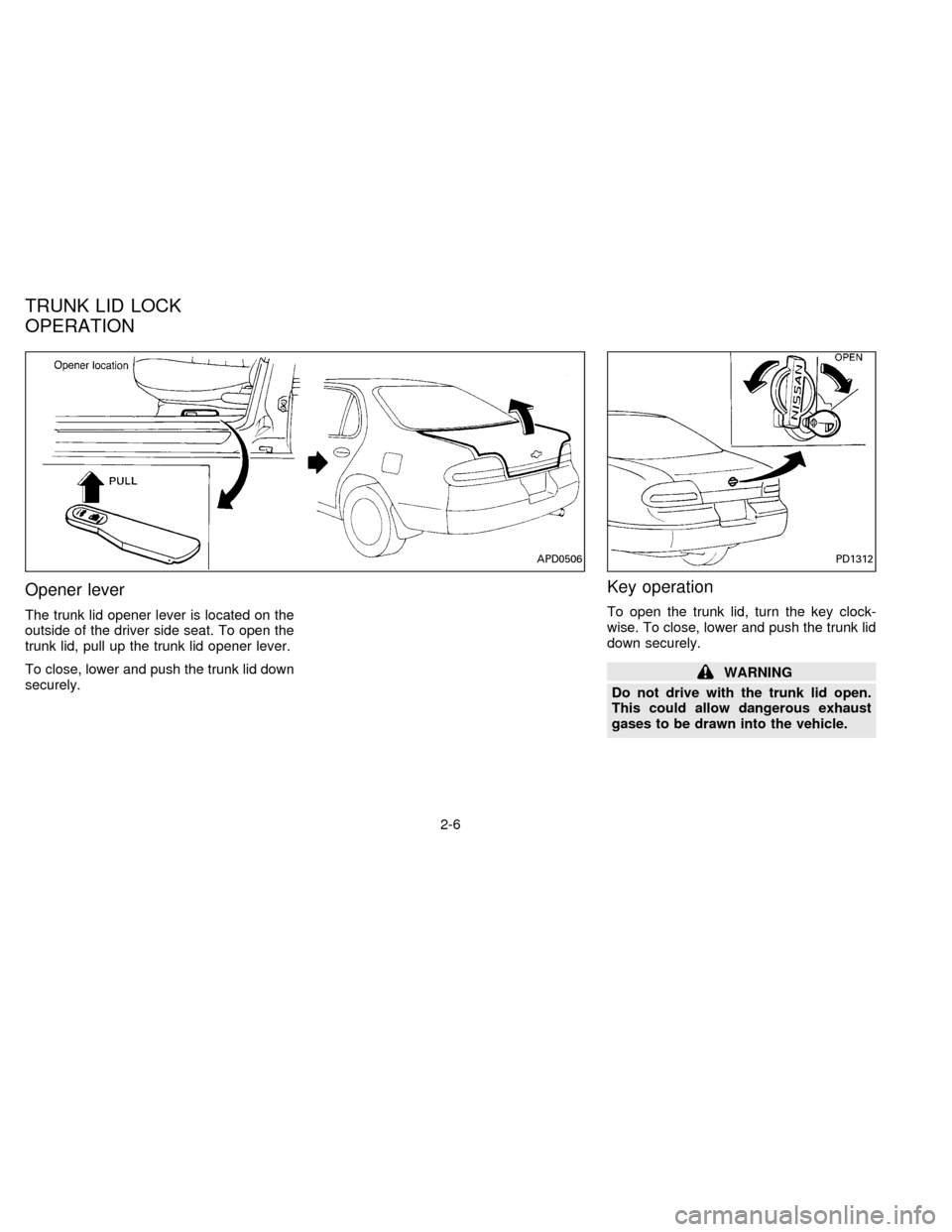
Opener lever
The trunk lid opener lever is located on the
outside of the driver side seat. To open the
trunk lid, pull up the trunk lid opener lever.
To close, lower and push the trunk lid down
securely.
Key operation
To open the trunk lid, turn the key clock-
wise. To close, lower and push the trunk lid
down securely.
WARNING
Do not drive with the trunk lid open.
This could allow dangerous exhaust
gases to be drawn into the vehicle.
APD0506PD1312
TRUNK LID LOCK
OPERATION
2-6
ZX
Page 32 of 183

OPENER CANCEL LEVER FOR
TRUNK LID
When this lever is in the ``CANCEL'' posi-
tion, the trunk lid cannot be opened with the
trunk lid opener lever. It can be opened only
with the key.
Opener lever
The fuel filler lid opener lever is located on
the outside of the driver side seat. To open
the fuel filler lid, push the opener lever
down. To lock, close the fuel filler lid se-
curely.
APD0111APD0525
FUEL FILLER LID LOCK
2-7
ZX
Page 33 of 183
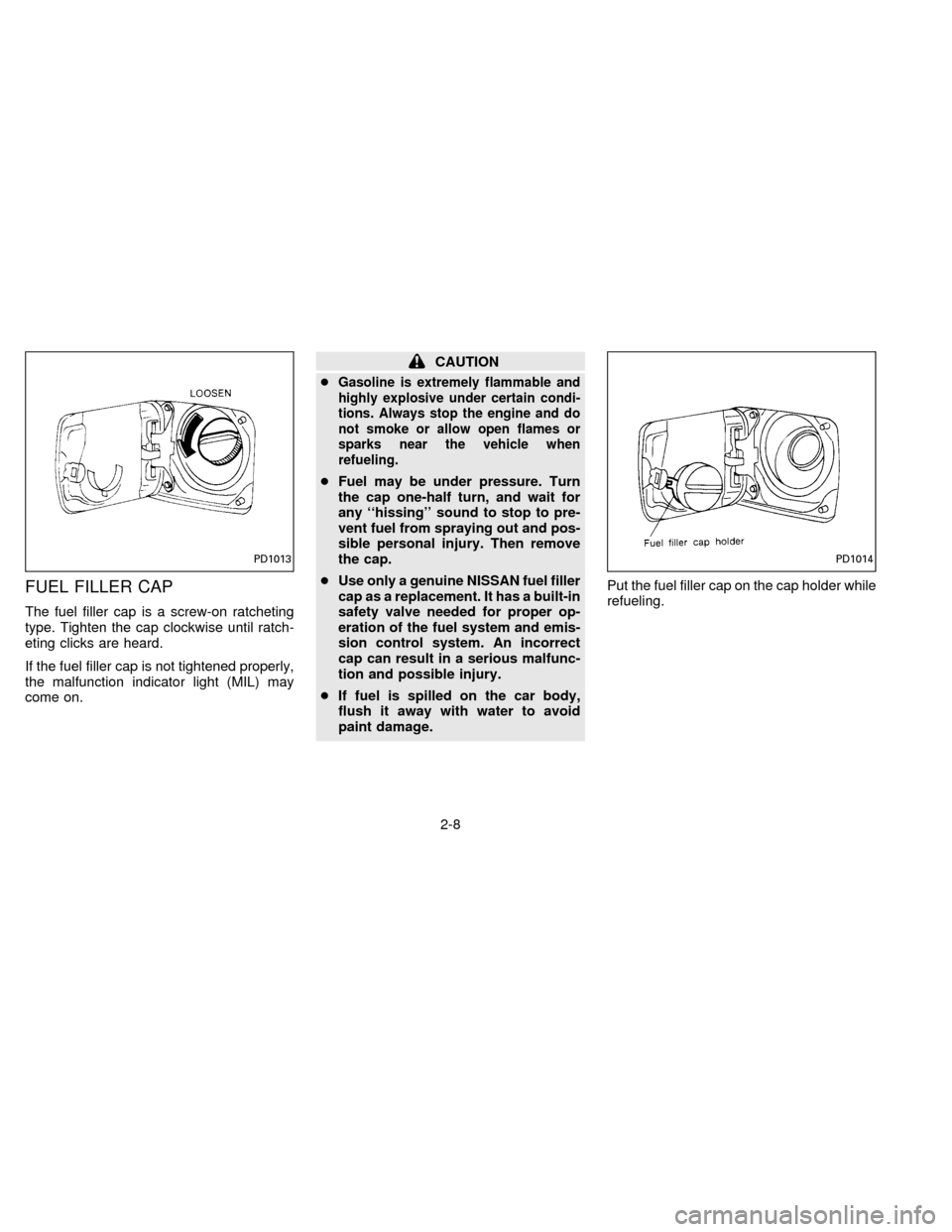
FUEL FILLER CAP
The fuel filler cap is a screw-on ratcheting
type. Tighten the cap clockwise until ratch-
eting clicks are heard.
If the fuel filler cap is not tightened properly,
the malfunction indicator light (MIL) may
come on.
CAUTION
c
Gasoline is extremely flammable and
highly explosive under certain condi-
tions. Always stop the engine and do
not smoke or allow open flames or
sparks near the vehicle when
refueling.
cFuel may be under pressure. Turn
the cap one-half turn, and wait for
any ``hissing'' sound to stop to pre-
vent fuel from spraying out and pos-
sible personal injury. Then remove
the cap.
cUse only a genuine NISSAN fuel filler
cap as a replacement. It has a built-in
safety valve needed for proper op-
eration of the fuel system and emis-
sion control system. An incorrect
cap can result in a serious malfunc-
tion and possible injury.
cIf fuel is spilled on the car body,
flush it away with water to avoid
paint damage.Put the fuel filler cap on the cap holder while
refueling.
PD1013PD1014
2-8
ZX
Page 34 of 183
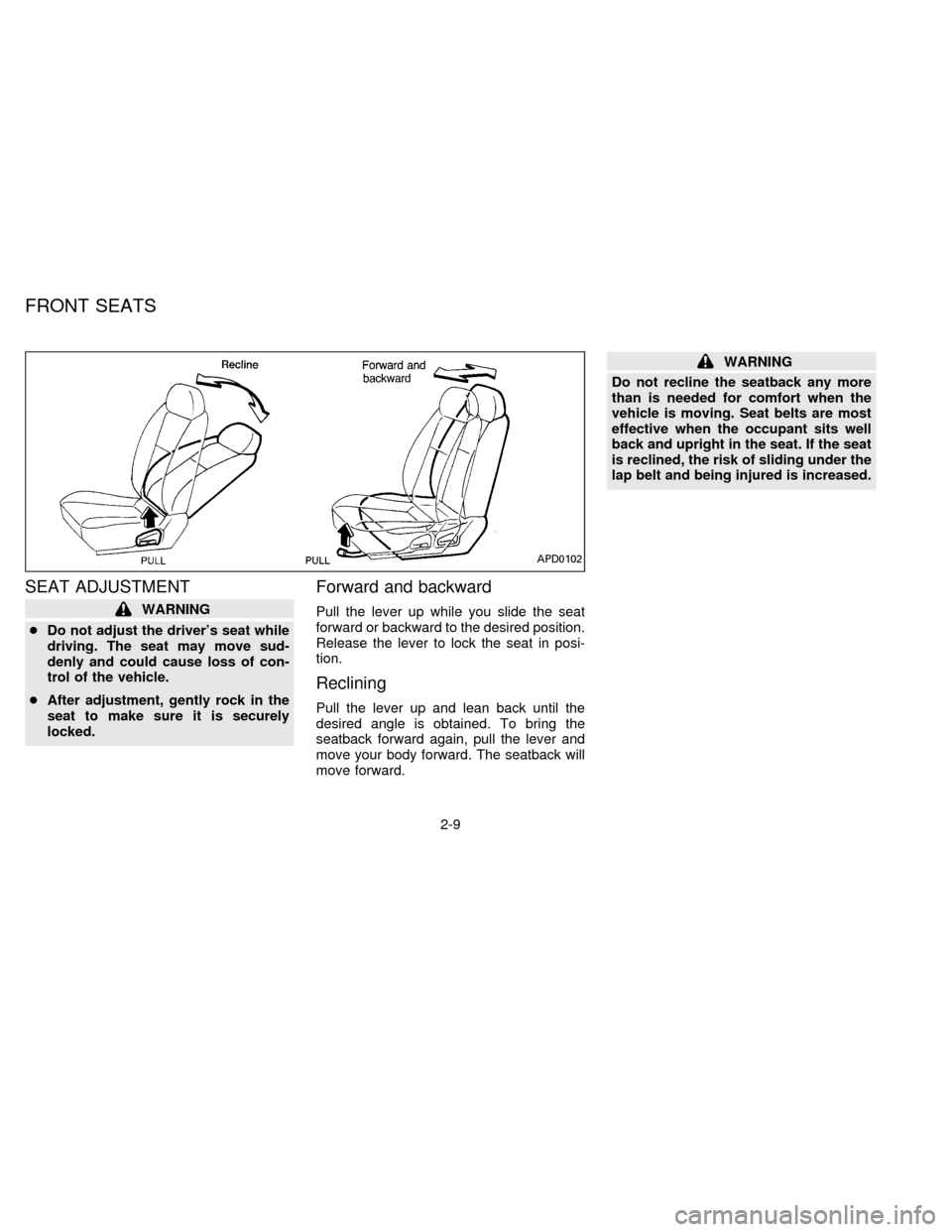
SEAT ADJUSTMENT
WARNING
cDo not adjust the driver's seat while
driving. The seat may move sud-
denly and could cause loss of con-
trol of the vehicle.
cAfter adjustment, gently rock in the
seat to make sure it is securely
locked.
Forward and backward
Pull the lever up while you slide the seat
forward or backward to the desired position.
Release the lever to lock the seat in posi-
tion.
Reclining
Pull the lever up and lean back until the
desired angle is obtained. To bring the
seatback forward again, pull the lever and
move your body forward. The seatback will
move forward.
WARNING
Do not recline the seatback any more
than is needed for comfort when the
vehicle is moving. Seat belts are most
effective when the occupant sits well
back and upright in the seat. If the seat
is reclined, the risk of sliding under the
lap belt and being injured is increased.
APD0102
FRONT SEATS
2-9
ZX
Page 35 of 183
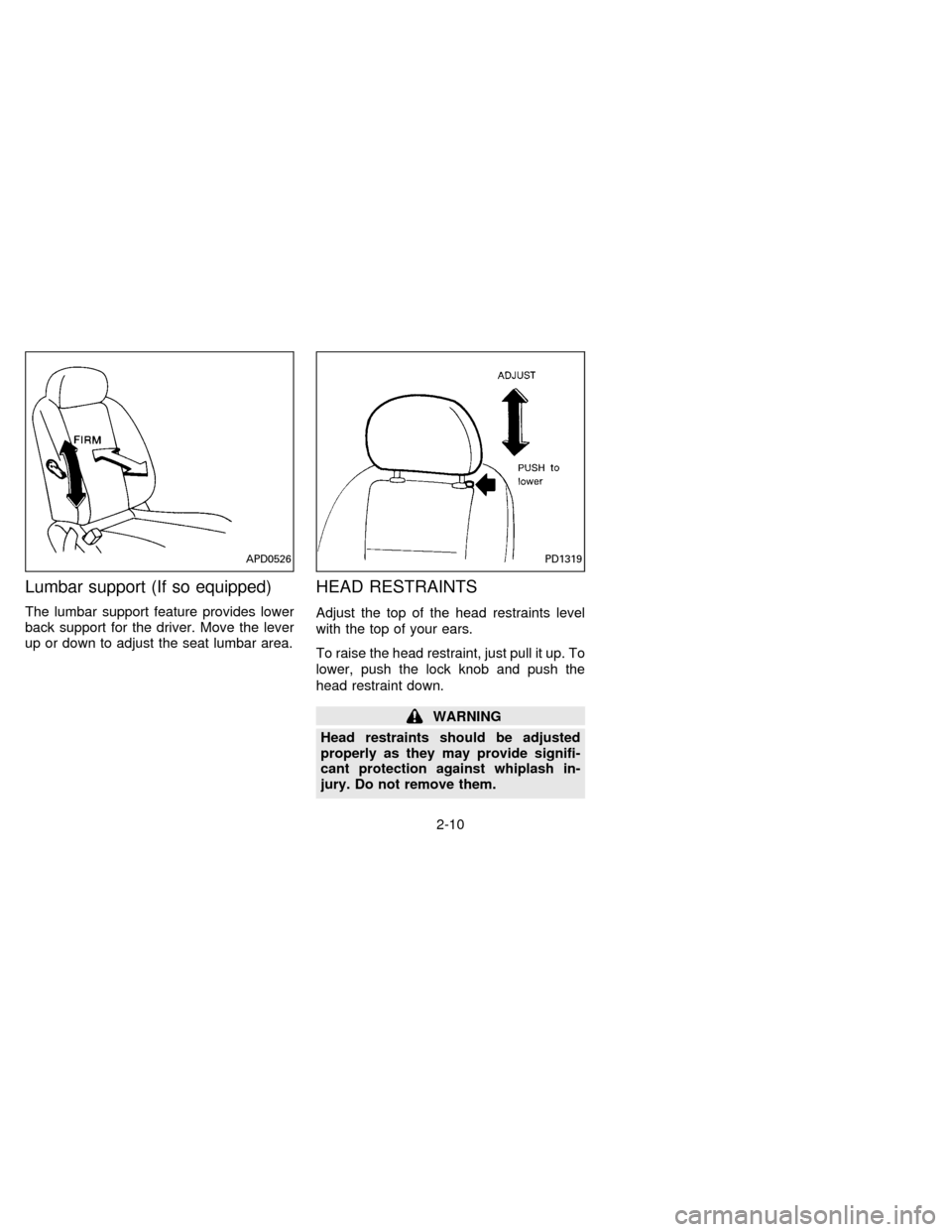
Lumbar support (If so equipped)
The lumbar support feature provides lower
back support for the driver. Move the lever
up or down to adjust the seat lumbar area.
HEAD RESTRAINTS
Adjust the top of the head restraints level
with the top of your ears.
To raise the head restraint, just pull it up. To
lower, push the lock knob and push the
head restraint down.
WARNING
Head restraints should be adjusted
properly as they may provide signifi-
cant protection against whiplash in-
jury. Do not remove them.
APD0526PD1319
2-10
ZX
Page 36 of 183

REAR SEAT
Center armrest and tray
Pull the armrest forward until it is horizontal.
Then release the lever (inset) and pull the
tray forward. With the armrest in this posi-tion you are able to gain access to the trunk.
PD1320
2-11
ZX
Page 37 of 183
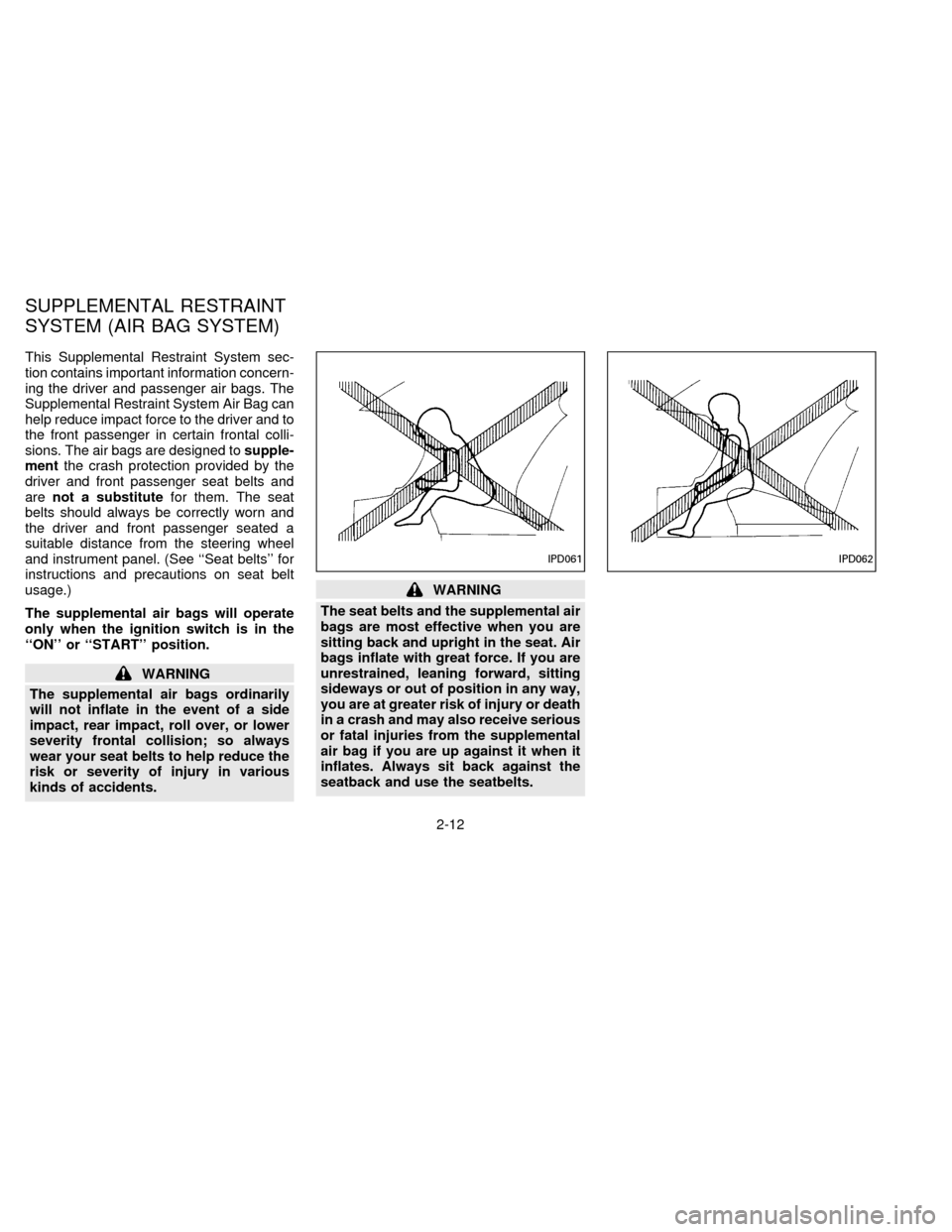
This Supplemental Restraint System sec-
tion contains important information concern-
ing the driver and passenger air bags. The
Supplemental Restraint System Air Bag can
help reduce impact force to the driver and to
the front passenger in certain frontal colli-
sions. The air bags are designed tosupple-
mentthe crash protection provided by the
driver and front passenger seat belts and
arenot a substitutefor them. The seat
belts should always be correctly worn and
the driver and front passenger seated a
suitable distance from the steering wheel
and instrument panel. (See ``Seat belts'' for
instructions and precautions on seat belt
usage.)
The supplemental air bags will operate
only when the ignition switch is in the
``ON'' or ``START'' position.
WARNING
The supplemental air bags ordinarily
will not inflate in the event of a side
impact, rear impact, roll over, or lower
severity frontal collision; so always
wear your seat belts to help reduce the
risk or severity of injury in various
kinds of accidents.
WARNING
The seat belts and the supplemental air
bags are most effective when you are
sitting back and upright in the seat. Air
bags inflate with great force. If you are
unrestrained, leaning forward, sitting
sideways or out of position in any way,
you are at greater risk of injury or death
in a crash and may also receive serious
or fatal injuries from the supplemental
air bag if you are up against it when it
inflates. Always sit back against the
seatback and use the seatbelts.
IPD062IPD061
SUPPLEMENTAL RESTRAINT
SYSTEM (AIR BAG SYSTEM)
2-12
ZX
Page 38 of 183
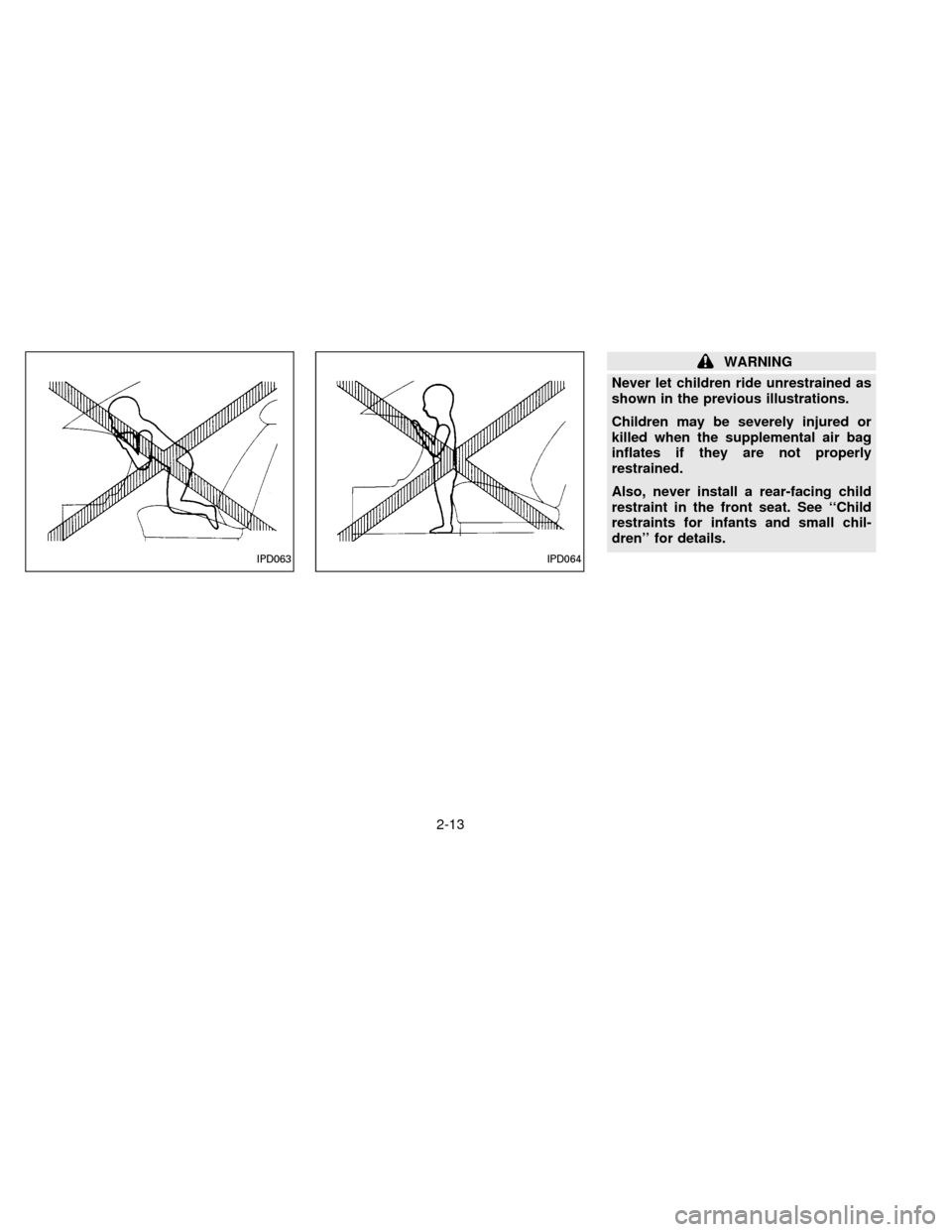
WARNING
Never let children ride unrestrained as
shown in the previous illustrations.
Children may be severely injured or
killed when the supplemental air bag
inflates if they are not properly
restrained.
Also, never install a rear-facing child
restraint in the front seat. See ``Child
restraints for infants and small chil-
dren'' for details.
IPD063IPD064
2-13
ZX
Page 39 of 183
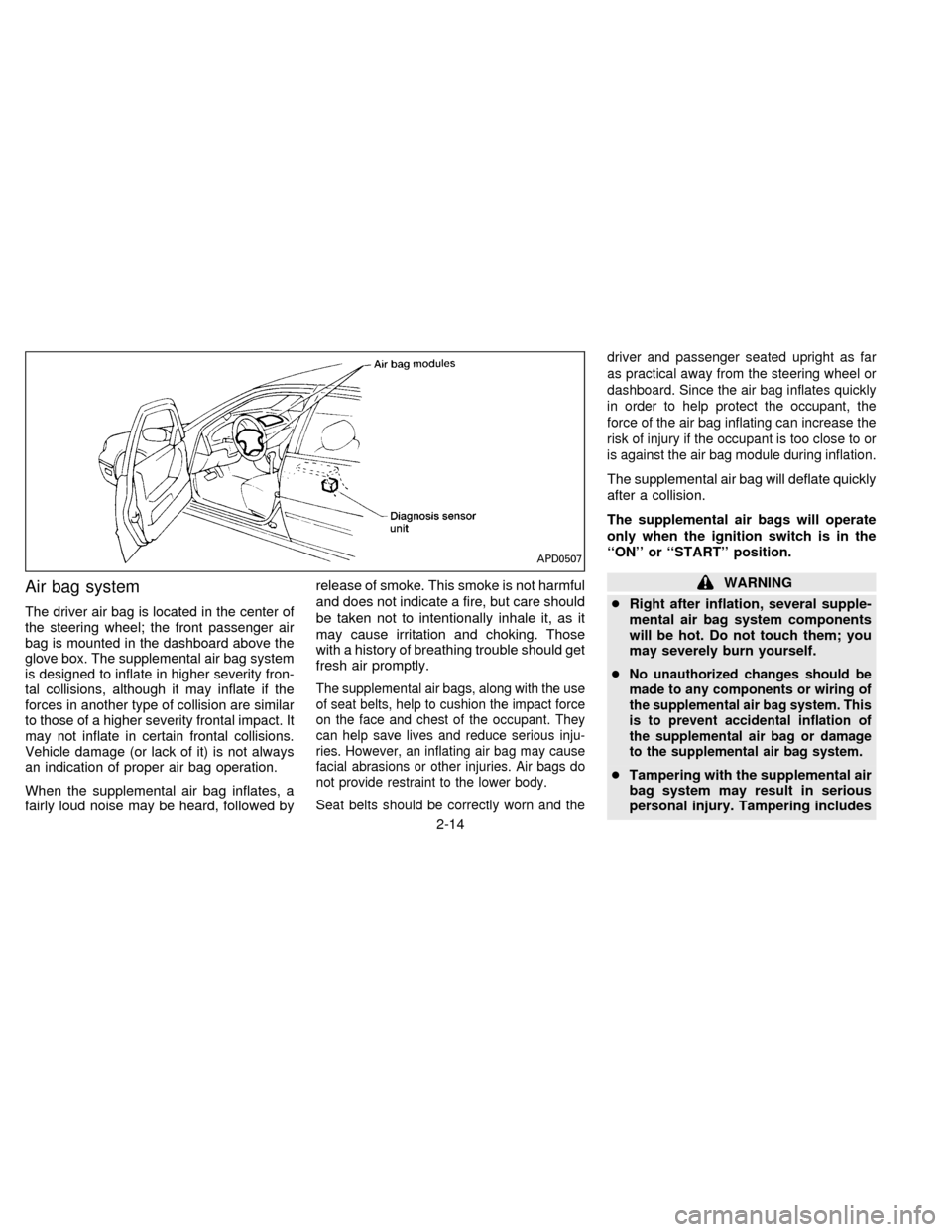
Air bag system
The driver air bag is located in the center of
the steering wheel; the front passenger air
bag is mounted in the dashboard above the
glove box. The supplemental air bag system
is designed to inflate in higher severity fron-
tal collisions, although it may inflate if the
forces in another type of collision are similar
to those of a higher severity frontal impact. It
may not inflate in certain frontal collisions.
Vehicle damage (or lack of it) is not always
an indication of proper air bag operation.
When the supplemental air bag inflates, a
fairly loud noise may be heard, followed byrelease of smoke. This smoke is not harmful
and does not indicate a fire, but care should
be taken not to intentionally inhale it, as it
may cause irritation and choking. Those
with a history of breathing trouble should get
fresh air promptly.
The supplemental air bags, along with the use
of seat belts, help to cushion the impact force
on the face and chest of the occupant. They
can help save lives and reduce serious inju-
ries. However, an inflating air bag may cause
facial abrasions or other injuries. Air bags do
not provide restraint to the lower body.
Seat belts should be correctly worn and thedriver and passenger seated upright as far
as practical away from the steering wheel or
dashboard. Since the air bag inflates quickly
in order to help protect the occupant, the
force of the air bag inflating can increase the
risk of injury if the occupant is too close to or
is against the air bag module during inflation.
The supplemental air bag will deflate quickly
after a collision.
The supplemental air bags will operate
only when the ignition switch is in the
``ON'' or ``START'' position.
WARNING
cRight after inflation, several supple-
mental air bag system components
will be hot. Do not touch them; you
may severely burn yourself.
c
No unauthorized changes should be
made to any components or wiring of
the supplemental air bag system. This
is to prevent accidental inflation of
the supplemental air bag or damage
to the supplemental air bag system.
cTampering with the supplemental air
bag system may result in serious
personal injury. Tampering includes
APD0507
2-14
ZX
Page 40 of 183
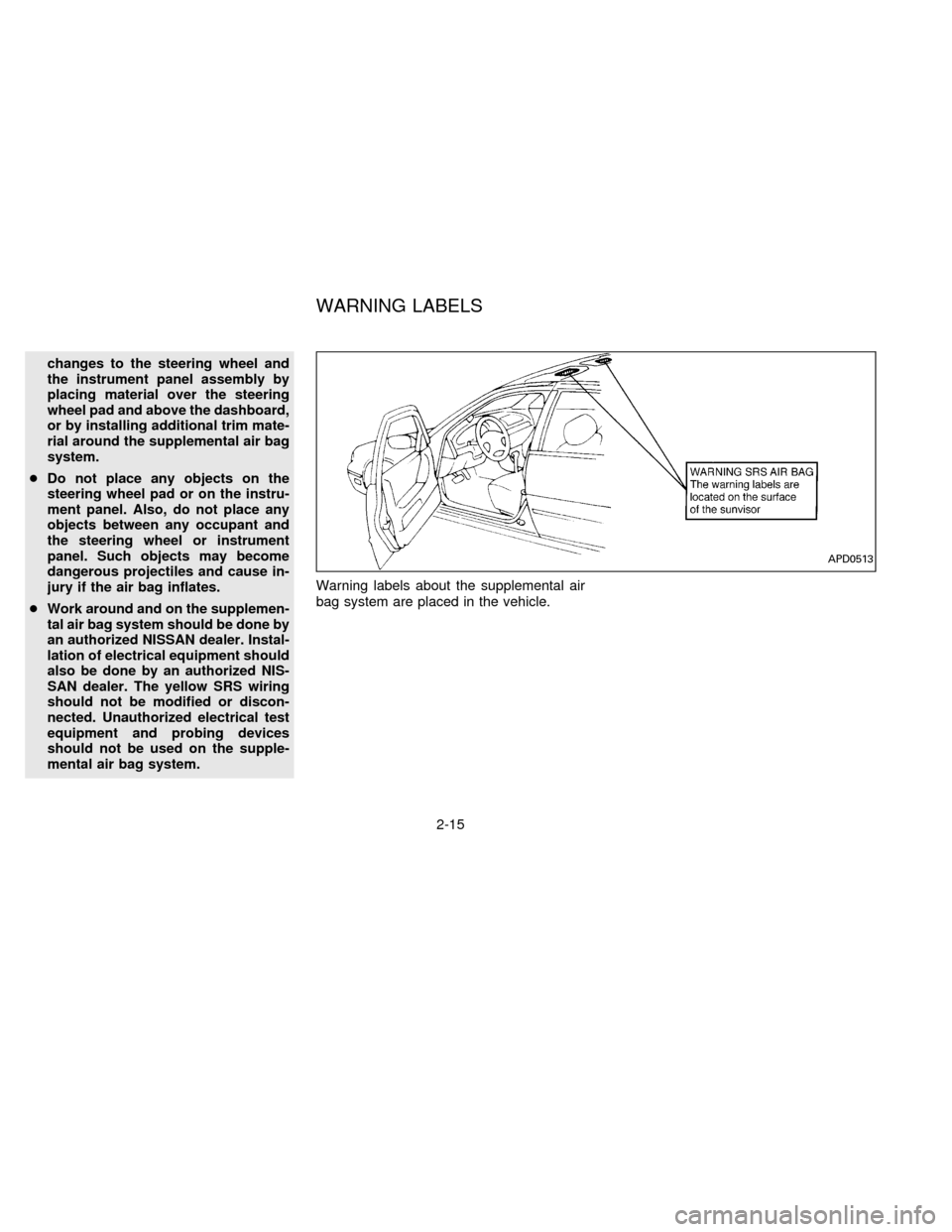
changes to the steering wheel and
the instrument panel assembly by
placing material over the steering
wheel pad and above the dashboard,
or by installing additional trim mate-
rial around the supplemental air bag
system.
cDo not place any objects on the
steering wheel pad or on the instru-
ment panel. Also, do not place any
objects between any occupant and
the steering wheel or instrument
panel. Such objects may become
dangerous projectiles and cause in-
jury if the air bag inflates.
cWork around and on the supplemen-
tal air bag system should be done by
an authorized NISSAN dealer. Instal-
lation of electrical equipment should
also be done by an authorized NIS-
SAN dealer. The yellow SRS wiring
should not be modified or discon-
nected. Unauthorized electrical test
equipment and probing devices
should not be used on the supple-
mental air bag system.Warning labels about the supplemental air
bag system are placed in the vehicle.
APD0513
WARNING LABELS
2-15
ZX